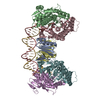+Search query
-Structure paper
| Title | Genome expansion by a CRISPR trimmer-integrase. |
|---|---|
| Journal, issue, pages | Nature, Vol. 618, Issue 7966, Page 855-861, Year 2023 |
| Publish date | Jun 14, 2023 |
 Authors Authors | Joy Y Wang / Owen T Tuck / Petr Skopintsev / Katarzyna M Soczek / Gary Li / Basem Al-Shayeb / Julia Zhou / Jennifer A Doudna /  |
| PubMed Abstract | CRISPR-Cas adaptive immune systems capture DNA fragments from invading mobile genetic elements and integrate them into the host genome to provide a template for RNA-guided immunity. CRISPR systems ...CRISPR-Cas adaptive immune systems capture DNA fragments from invading mobile genetic elements and integrate them into the host genome to provide a template for RNA-guided immunity. CRISPR systems maintain genome integrity and avoid autoimmunity by distinguishing between self and non-self, a process for which the CRISPR/Cas1-Cas2 integrase is necessary but not sufficient. In some microorganisms, the Cas4 endonuclease assists CRISPR adaptation, but many CRISPR-Cas systems lack Cas4. Here we show here that an elegant alternative pathway in a type I-E system uses an internal DnaQ-like exonuclease (DEDDh) to select and process DNA for integration using the protospacer adjacent motif (PAM). The natural Cas1-Cas2/exonuclease fusion (trimmer-integrase) catalyses coordinated DNA capture, trimming and integration. Five cryo-electron microscopy structures of the CRISPR trimmer-integrase, visualized both before and during DNA integration, show how asymmetric processing generates size-defined, PAM-containing substrates. Before genome integration, the PAM sequence is released by Cas1 and cleaved by the exonuclease, marking inserted DNA as self and preventing aberrant CRISPR targeting of the host. Together, these data support a model in which CRISPR systems lacking Cas4 use fused or recruited exonucleases for faithful acquisition of new CRISPR immune sequences. |
 External links External links |  Nature / Nature /  PubMed:37316664 / PubMed:37316664 /  PubMed Central PubMed Central |
| Methods | EM (single particle) |
| Resolution | 2.91 - 4.1 Å |
| Structure data | EMDB-29561, PDB-8fy9: EMDB-29562, PDB-8fya: EMDB-29563, PDB-8fyb: EMDB-29564, PDB-8fyc: EMDB-29565, PDB-8fyd: |
| Source |
|
 Keywords Keywords | DNA BINDING PROTEIN/DNA / CRISPR / integrase / CRISPR adaptation module / PAM / prespacer / exonuclease / DNA binding protein-DNA complex / enzyme / ribonucleoprotein |
 Movie
Movie Controller
Controller Structure viewers
Structure viewers About Yorodumi Papers
About Yorodumi Papers













 megasphaera (bacteria)
megasphaera (bacteria)